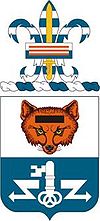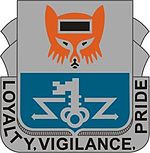302nd Military Intelligence Battalion (United States)
This article has multiple issues. Please help improve it or discuss these issues on the talk page. (Learn how and when to remove these messages)
|
The 302nd Military Intelligence Battalion (302nd MI BN), whose unit crest portrays the "sly fox", evolved from the 3252d Signal Service Company which was activated in England on 1 April 1944.
| 302nd Military Intelligence Battalion | |
|---|---|
 302nd Military Intelligence Coat of Arms | |
| Active | April 1944 – present |
| Country | United States |
| Branch | U.S. Army |
| Nickname(s) | Sly Fox |
| Motto(s) | Loyalty, Vigilance, Pride |
| Engagements | World War II Operation Desert Shield Operation Desert Storm Operation Iraqi Freedom |
| Decorations | Superior Unit Award Meritorious Unit Commendation(2) |
| Battle honours | Normandy Campaign |
| Insignia | |
| Distinctive Unit Insignia |  |
History
editThe 3252nd saw service in France and Germany before returning to Camp Kilmer, New Jersey, where it was deactivated in 1945. The unit was awarded battle credits for participation in the Invasion of Normandy. The 3252nd was re-designated the 533rd Signal Service Company in 1948 and served until 1949 in Salzburg, Austria.
In 1950, the 533rd Signal Service Company was re-designated the 302nd Communications Reconnaissance Battalion. It was assigned to the Army Security Agency and activated at Camp Pickett, Virginia. The unit departed Camp Pickett in 1951 to Fort Hood, Texas in 1952. In August 1952, the unit departed for Germany. In 1957, the 302nd was deactivated in Germany.
In 1975, the 302nd was reactivated in Germany and assigned to the 502nd Army Security Agency (ASA) in support of V Corps. In 1977, the battalion was transferred from the Army Security Agency to United States Army Europe (USAREUR).
In 1984, the 302nd was reorganized as the 302nd Military Intelligence Battalion, and subordinated to the 205th Military Intelligence Group of V Corps under the Combat Electronics Warfare Intelligence (CEWI) Concept. In 1985, the 302nd was subordinated from the 205th Military Intelligence Group to the 205th Military Intelligence Brigade.
In August 1990, a detachment deployed to Saudi Arabia for Operations Desert Shield and Desert Storm.[1] Through the nineties, the 302nd deployed to the Balkans and was awarded the Superior Unit Award.[2]
As part of V Corps, the 302nd deployed to Iraq for Operation Iraqi Freedom in 2003 and a subsequent rotation. The unit was awarded two Meritorious Unit Commendations. On 20 September 2003, Specialist Lunsford Brown, from Alpha Company, was killed in action at the Abu Ghraib prison in Iraq.[3]
On January 2, 2004, James Stacy Adams, the battalion's Command Sergeant Major, was found dead in his apartment.[4]
In 2007, the 302nd began its transformation into the 24th Military Intelligence Battalion. With the deactivation of the 205th Military Intelligence Brigade, in October 2007, the 302nd was assigned to USAREUR and attached to the 66th Military Intelligence Group.[5]
Unit Crest
edit"White and teal blue, are symbolic of the battalion's former status as an unassigned-to-branch unit. The battalion's war service as a signal unit is shown by the colors of the fox's mask and background, while the intelligence functions of the unit are represented by the black censor's stamp. The key is for the unit's first campaign (Normandy) in World War II and also alludes to signal and intelligence functions. The stylized lightning flashes symbolize radio reconnaissance."[6]
Decorations
edit- Meritorious Unit Commendation for Operation Iraqi Freedom 2005–2006[7]
Company A
edit- Meritorious Unit Commendation for Operation Iraqi Freedom 2003–2004[8]
References
edit- ^ John Pike. "302nd Military Intelligence Battalion". Globalsecurity.org. Retrieved 20 May 2011.
- ^ "302nd Military Intelligence Battalion". Archived from the original on 14 June 2008. Retrieved 22 December 2009.
- ^ "Army Spc. Lunsford B. Brown II". Fallen Heroes Memorial. 20 September 2003. Retrieved 20 May 2011.
- ^ J David Galland (25 May 2004). "Unanswered Questions About a Military Leader's Sudden Death". Military.com. Archived from the original on 14 October 2013.
- ^ [1][dead link]
- ^ "302nd MI Bn". Nasaa-home.org. Archived from the original on 25 July 2011. Retrieved 20 May 2011.
- ^ "Permanent Orders 222-20". United States Army Center of Military History. 14 August 2007. Archived from the original on 9 June 2010. Retrieved 25 June 2010.
- ^ "Permanent Orders 222-19". United States Army Center of Military History. 14 August 2007. Archived from the original on 9 June 2010. Retrieved 25 June 2010.
External links
edit- Media related to File:Fay Report Annex -- Statement of Specialist, 302nd Military Intelligence Battalion re -- Detainee Handling at Abu Ghraib Prison -b.pdf at Wikimedia Commons
- Media related to Fay Report Annex -- Statement of Specialist, 302nd Military Intelligence Battalion re -- Detainee Handling at Abu Ghraib Prison -b.pdf at Wikimedia Commons
- Media related to Fay Report Annex -- Statement of Sergeant, 302nd Military Intelligence Battalion re- Possible Detainee Abuse at Abu Ghraib Prison -a.pdf at Wikimedia Commons
- Media related to Fay Report Annex -- Statement of Intelligence Analyst, 302nd Military Intelligence Battalion re- Detainee Treatment and Handling at Abu Ghraib Prison -a.pdf at Wikimedia Commons
- Media related to DOD Memo -- Statement of Military Intelligence Officer, A Company, 302nd Military Intelligence Battalion re -- Detainee Interrogations at Abu Ghraib Prison.pdf at Wikimedia Commons